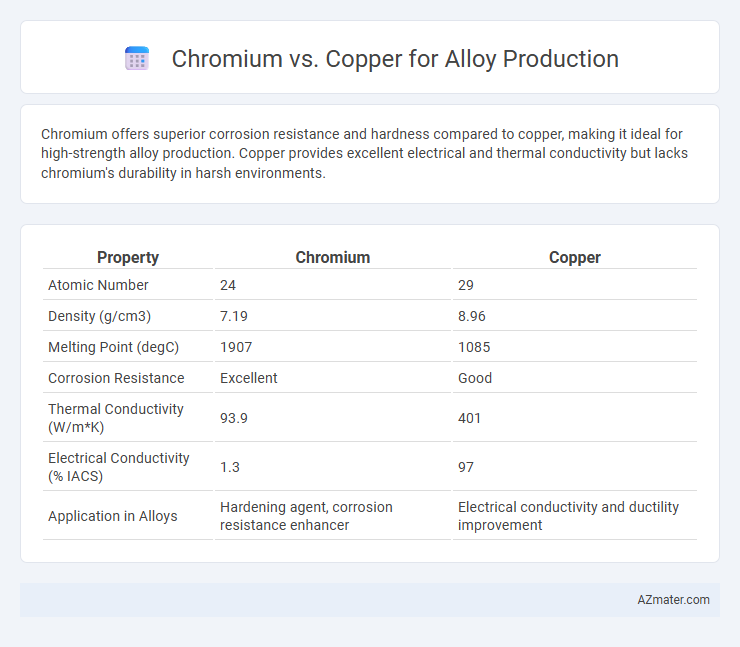Chromium offers superior corrosion resistance and hardness compared to copper, making it ideal for high-strength alloy production. Copper provides excellent electrical and thermal conductivity but lacks chromium's durability in harsh environments.
Table of Comparison
| Property | Chromium | Copper |
|---|---|---|
| Atomic Number | 24 | 29 |
| Density (g/cm3) | 7.19 | 8.96 |
| Melting Point (degC) | 1907 | 1085 |
| Corrosion Resistance | Excellent | Good |
| Thermal Conductivity (W/m*K) | 93.9 | 401 |
| Electrical Conductivity (% IACS) | 1.3 | 97 |
| Application in Alloys | Hardening agent, corrosion resistance enhancer | Electrical conductivity and ductility improvement |
Overview of Chromium and Copper in Alloy Production
Chromium enhances alloy production by imparting exceptional hardness, corrosion resistance, and high-temperature stability, essential for stainless steels and superalloys. Copper contributes to alloy durability and electrical conductivity, often used in brass and bronze to improve machinability and resistance to corrosion. The combination of both elements in alloys results in materials with balanced strength, corrosion resistance, and thermal properties suitable for industrial applications.
Chemical Properties: Chromium vs Copper
Chromium exhibits high corrosion resistance and forms a stable oxide layer, making it essential for enhancing hardness and durability in alloys. Copper possesses excellent electrical and thermal conductivity, along with natural antimicrobial properties, which improves alloy performance in conductive and antimicrobial applications. Both metals contribute distinct chemical properties that influence alloy characteristics such as strength, resistance to oxidation, and conductivity.
Mechanical Strength and Durability Comparison
Chromium enhances alloy mechanical strength by increasing hardness and tensile strength, making it ideal for applications requiring high wear resistance and durability. Copper alloys offer excellent corrosion resistance and thermal conductivity but generally exhibit lower tensile strength compared to chromium-enhanced alloys. The choice between chromium and copper in alloy production depends on the balance needed between mechanical strength and specific environmental durability requirements.
Corrosion Resistance: Chromium vs Copper Alloys
Chromium alloys exhibit superior corrosion resistance compared to copper alloys due to the formation of a stable, adherent oxide layer that protects the metal surface from environmental degradation. Copper alloys, while providing good resistance to certain corrosive agents like seawater and atmospheric exposure, generally show greater susceptibility to corrosion in acidic or chloride-rich environments. The enhanced passivation properties of chromium-based alloys make them optimal for applications requiring long-term durability and resistance to harsh chemical conditions.
Thermal and Electrical Conductivity Differences
Chromium exhibits significantly lower thermal and electrical conductivity compared to copper, with copper's thermal conductivity around 400 W/mK versus chromium's approximately 93 W/mK, making copper ideal for applications requiring efficient heat dissipation. In alloy production, copper enhances electrical conductivity, achieving values near 58 MS/m, whereas chromium substantially lowers conductivity but improves hardness and corrosion resistance. The stark contrast in these properties influences alloy selection based on desired thermal management and electrical performance criteria.
Alloying Processes: Techniques for Chromium and Copper
Chromium alloying processes primarily involve adding chromium in the molten steel during the melting phase to improve hardness, corrosion resistance, and tensile strength, often achieved through techniques such as vacuum arc remelting or induction melting. Copper alloying typically uses a controlled addition of copper to molten metal or solid-state diffusion methods, enhancing corrosion resistance and electrical conductivity in alloys like brass and bronze. Both elements require precise temperature control and mixing to ensure uniform distribution and optimal alloy properties.
Cost Analysis: Chromium vs Copper Alloys
Chromium alloys generally exhibit higher raw material costs compared to copper alloys due to the scarcity and complex extraction processes of chromium. Copper alloys benefit from broader availability and lower market prices, making them more cost-effective for large-scale alloy production. Factoring in manufacturing expenses, chromium alloys may incur elevated processing costs given their higher melting points and harder machinability.
Environmental Impact and Sustainability
Chromium offers corrosion resistance and hardness that extends alloy lifespan, reducing the need for frequent replacements and lowering resource consumption. Copper's recyclability supports circular economy practices, minimizing mining impacts and energy use during production. Both metals present unique environmental profiles; however, sustainable sourcing and efficient recycling are critical to mitigating their ecological footprints in alloy manufacturing.
Industrial Applications: Chromium and Copper Alloys
Chromium and copper alloys serve critical roles in industrial applications due to their distinct properties. Chromium alloys are prized for their high corrosion resistance, hardness, and ability to withstand extreme temperatures, making them ideal for stainless steel production, aerospace components, and automotive parts. Copper alloys, known for excellent electrical conductivity and thermal performance, are commonly used in electrical wiring, heat exchangers, and marine hardware, emphasizing their versatility in electrical and thermal management industries.
Future Trends in Alloy Production with Chromium and Copper
Future trends in alloy production emphasize increased use of chromium to enhance corrosion resistance and strength, particularly in stainless steel and high-performance alloys. Innovations in copper alloys target improved electrical conductivity and thermal performance for advanced electronics and renewable energy applications. Emerging research explores hybrid alloys combining chromium and copper to optimize durability and conductivity for next-generation industrial uses.

Infographic: Chromium vs Copper for Alloy Production
 azmater.com
azmater.com